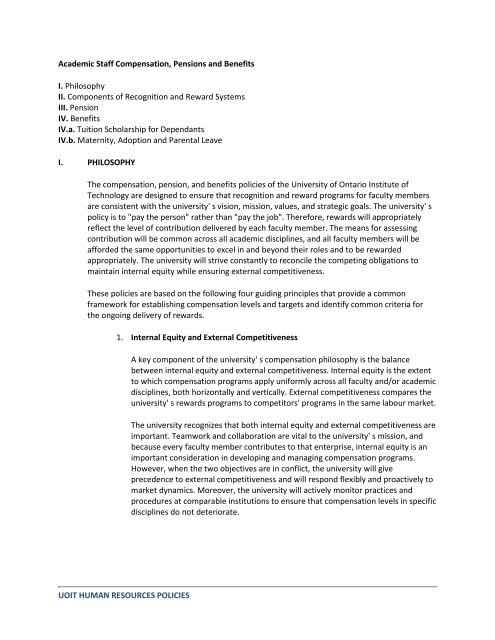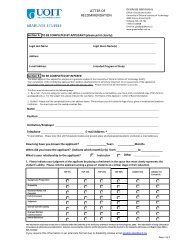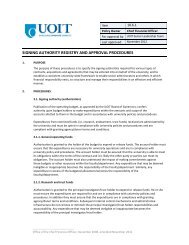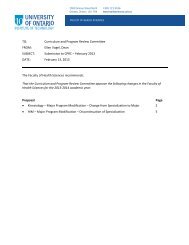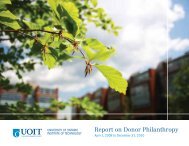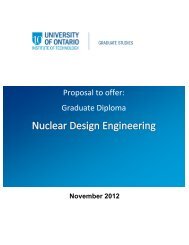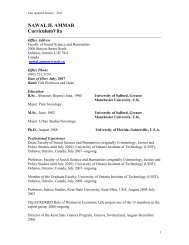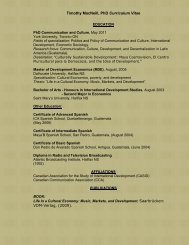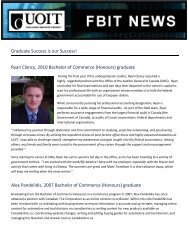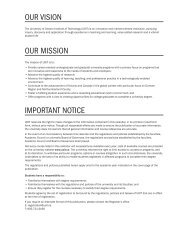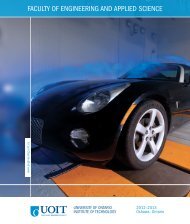UOIT HUMAN RESOURCES POLICIES Academic Staff ...
UOIT HUMAN RESOURCES POLICIES Academic Staff ...
UOIT HUMAN RESOURCES POLICIES Academic Staff ...
You also want an ePaper? Increase the reach of your titles
YUMPU automatically turns print PDFs into web optimized ePapers that Google loves.
2. PerformanceThe university' s recognition and reward programs reflect appropriately thecontribution each faculty member makes to the mission of the university.Accordingly, these programs are structured to deliver the most compensation tothose individuals who deliver outstanding results in ways that reinforce the valuesand goals of the institution.Performance has two dimensions: what is accomplished and how it is accomplished.The university' s compensation programs are linked to the goals and expectationsidentified through the performance management process, and are the principalmeans through which the effectiveness of teaching, quality and quantity ofresearch, service to the university, and growth and development are recognized.3. FlexibilityThe university' s recognition and reward programs provide a consistent frameworkfor all faculty members, but allow for differing amounts of pay to be delivered toindividual faculty members. These differences may be based on the competitivelabour market and/or a faculty member' s level of contribution. Allowing fordifferentiation supports the university' s mission as a market-driven institution andrecognizes excellence in the facilitation of learning and value-added research.4. Open CommunicationThe university' s recognition and reward programs shall be openly communicated.Written materials describing all programs shall be clear and easy to understand.Leaders responsible for communicating with faculty members about programs andpolices shall be encouraged and trained to do so in a manner that is open, honest,and respectful. The university' s goals are to create an environment in which facultymembers are comfortable asking questions about compensation programs and toensure that faculty members' concerns, grievances, and suggestions will be heardand responded to in a timely way.II.COMPONENTS OF RECOGNITION AND REWARD SYSTEM1. Base SalaryBecause base salary serves as the foundation of the university' s total compensationpackage, it is particularly important to define its purpose and role clearly within thesystem of recognition and reward. In order to balance competitive needs withaffordable wages, the university provides base salaries that will be targeted to be inthe top one-third of Ontario Universities.Base salary reflects the contribution a faculty member makes to the university asmeasured by her/his depth and breadth of knowledge, skills, experience, and ability.<strong>UOIT</strong> <strong>HUMAN</strong> <strong>RESOURCES</strong> <strong>POLICIES</strong>
Salary progressions reward faculty members for performing in ways that supportthe vision, mission, values, and goals of the university. Accordingly, the salary ofeach faculty member will be reviewed annually in the context of competitivecompensation levels for faculty positions across all academic disciplines, ensuringthat base pay targets remain competitive and sensitive to changing marketconditions.2. Salary EnhancementsSalary enhancements shall be granted in two forms:Across the Board [ATB] Adjustments:Each year an ATB adjustment budget shall be established by the President based ona review of inflation, market conditions, and the financial state of the university.ATB adjustments will be granted as a common percentage of base salary and willgenerally be provided to all faculty members. Faculty members who do not meetbasic performance requirements, as defined by the university' s performancemanagement process, are not eligible to receive ATB adjustments.Merit Adjustment:Merit is the prevailing factor in all other recommended salary adjustments. Eachfaculty member shall be assessed annually with respect to:The facilitation of learningThe facilitation of learning is a fundamental purpose of the university wherebyfaculty members convey information and techniques and foster critical and creativethinkingResearchResearch is the second fundamental purpose of the university whereby facultymembers make original contributions to their fields of learning which inform theirteaching and enhance the academic reputation of the university.ServiceThe service of faculty members, both as citizens of the university and of the societybeyond, is critical to the effective functioning of the university.3. Performance AssessmentIn the spring of each academic year, each Dean will meet individually with everyfaculty member appointed in her/his School to establish performance objectives for<strong>UOIT</strong> <strong>HUMAN</strong> <strong>RESOURCES</strong> <strong>POLICIES</strong>
the following three years. Jointly with the Dean, each faculty member will establishobjectives for teaching, research, and service to the university. These objectives willbe articulated according to the following principles:In the understanding that the more clearly a goal is defined, the more likely itwill be achieved; objectives will specify the result to be achieved, rather thanthe job or task to be performed.In the understanding that measurement is the foundation for ensuring thatgoals are fairly assessed, objectives will specify how successful outcomes will berecognized, describe how results will be quantified, and identify the observableevents and behaviours that indicate when objectives have been achieved.In the understanding that agreed-upon goals ensure the coordination andcommitment necessary to accomplish objectives within a specified performanceperiod, the Dean may request more detailed or specific information.In the understanding that relevant goals are, by definition, those aligned withthe university' s goals, values, and mission, the Dean may require additionalobjectives.In the understanding that performance must be quantified, goals will bemeasured through ongoing review and with specific, scheduled milestones forprogress against a schedule.In the annual performance review, the faculty member and the Dean will discuss thefaculty member' s performance in the preceding year relative to previously statedobjectives. To assist the Deans in this process, the university requires a multi-sourceperformance assessment. The guidelines for this process apply in the understandingthat in order to maintain maximum objectivity, it is important that those in the bestposition to evaluate performance against specific goals participate in the process.Therefore:Teaching will be assessed in the context of formal student evaluations;Research will be assessed in the context of peer evaluation of quality ofresearch, publication, and creative professional practice.Service will be assessed in the context of feedback from relevant sources,potentially including the President, Provost, Dean, and other colleagues.It is anticipated that the weighting of these three factors in evaluation of merit willbe 40%, 40% and 20%.4. Merit Program FundingThe merit budget pool shall be established annually by the President. In establishingthis budget, the President will consider the expected performance levels of allfaculty members, market conditions, such as "hot skills", not addressed by the ATBadjustment, and affordability. Normally, the merit budget pool shall be in the rangeof two to three per cent of the academic salary budget.<strong>UOIT</strong> <strong>HUMAN</strong> <strong>RESOURCES</strong> <strong>POLICIES</strong>
5. Salary Progression FrameworkA salary floor, or minimum, will be reviewed and, if necessary, updated, annually.The floor will be based on the current market rate for a newly graduated Ph.D., andmay vary by academic discipline.6. Variable PayVariable pay is the primary means of reinforcing the university' s market focus andentrepreneurial spirit. In contrast to the objectives for base salary, the variable payprograms serve a different function. Variable pay:Recognizes the risk associated with joining a new academic institution byproviding a better-than-competitive total compensation opportunity, includingthe provision of above-market rewards for performance linked to helping buildthe university.Stimulates and rewards the contribution that contract research makes to theinfrastructure costs of the university. Variable pay is designed to motivatefaculty members to secure and conduct contract research in ways that areconsistent with the values of the institution.Shares success by recognizing collaborative efforts and ensuring that allcollaborators share the rewards of these efforts appropriately. Variable pay alsoallows the university to recognize individual successes that reinforce theinstitution' s collective mission and goals.Under the university' s variable pay program, faculty members have the opportunityto earn an additional amount up to 25% of annual base salary (i.e. the equivalent ofthree months' pay).The program will be funded from external sources by structuring one or moreresearch contracts to include a fee component that will be paid directly to thefaculty member(s) securing the contract.III.PENSIONThe university will administer a defined contribution pension plan registered under the PensionBenefits Act (Ontario).EligibilityEvery faculty member is required to join the plan on the date of hire. Both the University andfaculty members shall continue to make contributions in accordance with the Pension Planrequirements as set out in this section for those faculty members who have postponed theirretirement beyond their Normal Date of Retirement (NDR), which is the June 30 th following astaff member's 65 th birthday. However, pursuant to the Income Tax Act, faculty members will berequired to commence pension benefits no later than the end of the calendar year in which a<strong>UOIT</strong> <strong>HUMAN</strong> <strong>RESOURCES</strong> <strong>POLICIES</strong>
faculty member attains age 71 or at such other date as may be required by the Income Tax Act(the required pension start date).Pensionable earningsPensionable earnings include base salary, stipends, and any variable pay paid by or through theuniversity.Member contributionsEvery plan member will be required to contribute 3% of pensionable earnings to the plan andmay make voluntary contributions of up to a further 3% of pensionable earnings.University contributionsThe university will contribute a total of 8% of pensionable earnings to the plan, with twocomponents:A basic contribution of 6% of pensionable earnings;A supplemental contribution of 2% of pensionable earnings.Each plan member will make an election each year in advance to direct part or all of her/hissupplemental contributions to the Defined Contribution Pension Plan or to the Health CareExpense Account (HCEA).VestingUniversity contributions to the plan vest immediately.Investment optionsFaculty members will direct the investment of both university and member contributions. Awide range of investment options will be offered.Supplemental Retirement ArrangementUniversity contributions above the Income Tax Act (ITA) limit* on combined contributions to aregistered pension plan will be directed to a Defined Contribution Supplemental RetirementArrangement (DC SRA).The university will set aside funds as a reserve. However, assets cannot be held in trust withoutbecoming taxable.*ITA contribution limit for 2012 is $23,820 and this is subject to change year over year asdetermined by the Canada Revenue Agency.<strong>UOIT</strong> <strong>HUMAN</strong> <strong>RESOURCES</strong> <strong>POLICIES</strong>
IV.a.Dependant Tuition Reimbursement Program (DTAP)PURPOSEAs a benefit for full time continuing employees, the University assists in the costs of anundergraduate post-secondary education for an employee’s spouse and dependants.POLICYUnder the provisions of the Dependant Tuition Assistance Program (DTAP) the University ofOntario Institute of Technology (<strong>UOIT</strong>) will provide funding to defray the cost of tuition for aneligible employee’s spouse and/or dependant(s) who is/are enrolled in a full timeundergraduate program of study at an Ontario post-secondary institution.SCOPE AND AUTHORITYDefinitionsEligible Student is a student who is:i. the dependant or spouse of an eligible employee, andii. enrolled as a full-time student in an eligible Program of Study at any recognized postsecondaryinstitution in Ontario.Eligible Employee is an employee of the University of Ontario Institute of Technology (<strong>UOIT</strong>)who:i. is employed in a full time continuing capacity, andii. has completed six months of employment prior to the start of the first semester forwhich application for the DTAP benefit is made.Dependant is a child who:i. is less than 25 years of age, andii. is dependent for support on the eligible employee.NOTE: The age restriction of 25 years does not apply to a Dependant with a physical or mentaldisability who had this disability before the age of 25 years.Child includes:i. a child of the eligible employee, orii. a step-child of the eligible employee, oriii. an adopted child of the eligible employee.<strong>UOIT</strong> <strong>HUMAN</strong> <strong>RESOURCES</strong> <strong>POLICIES</strong>
Spouse is:i. a person married to an eligible employee under any formal union recognized by law,orii. a partner of the eligible employee who is of the opposite sex or of the same sex andwho is publicly represented to be the spouse of the eligible employee.Program of Study means:i. a full time Program of Study leading to an undergraduate degree or College certificateat any recognized post-secondary institution in Ontario, andii. the first such Program of Study funded under the DTAP for the Dependant or spouse.DTAP Benefit means:PROGRAMi. the partial reimbursement of tuition paid for a Program of Study of an Eligible Student.The University shall establish annually a fixed sum of money available for the DTAP.Eligible Employees will follow the procedure to apply for the DTAP benefit for a Program ofStudy for their Eligible Student.Eligible Students are eligible to receive the DTAP benefit for a Program of Study in an amount ofup to 50% of the tuition for a first year Bachelor of Arts (B.A.) program at <strong>UOIT</strong> for thesemester(s) for which the application is being made.Should the total value of all DTAP applications from all Eligible Students for the year exceed thefixed funds available, the amount of the DTAP benefit will be determined on a pro-rata basissuch that there will be an equal sharing of available funds amongst all Eligible Students.<strong>UOIT</strong> will pay the DTAP benefit to the Eligible Student following the latest Program of Studywithdrawal date in effect at <strong>UOIT</strong>. <strong>UOIT</strong> will provide the Eligible Student with a T4A for theamount of the DTAP benefit.In the event the employment of the eligible employee is terminated for any reason during thetime in which the Eligible Student is receiving the DTAP benefit, the DTAP benefit shall continuefor the duration of the academic semester in which the termination of employment occurs.The DTAP benefit is available for a maximum of up to four academic years in the Program ofStudy per Eligible Student. The value of the DTAP benefit per Eligible Student does not change ininstances where the Eligible Student is the Dependant of more than one Eligible Employee.<strong>UOIT</strong> <strong>HUMAN</strong> <strong>RESOURCES</strong> <strong>POLICIES</strong>
PROCEDURESThe eligible employee will complete the DTAP Application Form and supply proof of the EligibleStudent’s enrolment in a Program of Study and proof of payment of tuition fees for the Programof Study to the Human Resources department by the dates designated by Human Resources.IV.b.MATERNITY, ADOPTION AND PARENTAL LEAVEThe university wishes to ensure that full-time faculty members who choose to have children donot suffer financial disadvantage.Under the Employment Standards Act (ESA,) the natural (birth) mother is eligible for an unpaidleave of up to 52 weeks, comprising a two week waiting period, 15 weeks' maternity leave and35 weeks' parental leave. The natural father, or, in the case of adoption, either adoptive parent,is entitled to an unpaid leave of up to 37 weeks, comprising a two week waiting period and 35weeks' leave.Under the federal Employment Insurance Act (EI,) the natural (birth) mother is entitled toreceive benefits under the Supplementary Unemployment Benefits Plan (SUB) for up to 50weeks, comprising 15 weeks' maternity benefits and 35 weeks' parental leave benefits. Underthis program, the natural father or, in the case of adoption, either adoptive parent, on a sharedbasis, is eligible for a maximum of 35 weeks' parental leave benefits. Under the SUB plan, thenatural mother is eligible to receive the difference between the unemployment insurancebenefit and 93% of her annual salary for a maximum of 50 weeks.The Compensation, Pension and Benefit Programs Policy was approved by the Board of Governors onDecember 11, 2002 and was amended on November 10, and November 8, 2006.<strong>UOIT</strong> <strong>HUMAN</strong> <strong>RESOURCES</strong> <strong>POLICIES</strong>


